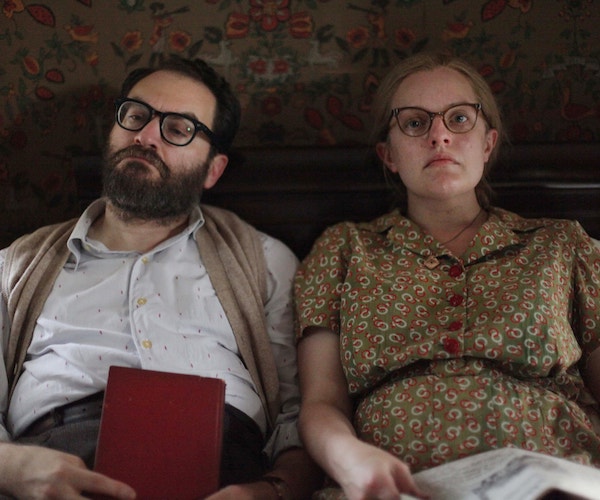Film Review: “Shirley” — Domestic Witchcraft
By Peg Aloi
Shirley is hard to watch, hard to resist, and deeply, deliciously haunting.
Shirley, directed by Josephine Decker. Streaming on Amazon Prime and Hulu.

Elisabeth Moss in Shirley. Photo: Thatcher Keats/Neon.
Writer Shirley Jackson’s work has experienced a recent flurry of interest, partly due to the popular adaptation of her 1959 novel The Haunting of Hill House in a 2018 Netflix series. Her disturbingly realistic dystopian short story “The Lottery” attained iconic status when it was first published by The New Yorker in 1948. That publishing stir catapulted Jackson into literary prominence and it frames Shirley, an odd biopic-fantasy hybrid narrative, adapted from Susan Scarf Merrell’s novel Shirley by Sarah Gubbins (FX series Better Things).
The opening scene shows 20 year old Rose (Odessa Young) reading “The Lottery” while riding a train, seated next to her husband Fred (Logan Lerman). The two then share a steamy, illicit moment in an empty compartment, before arriving at the home of Shirley Jackson (Elisabeth Moss) and her husband Stanley Hyman (Michael Stuhlbarg). Stanley’s a folk music scholar at Bennington College (he plays songs by Leadbelly for his classes). Fred’s a recent PhD recipient, hoping to get a job, for now doing academic grunt work for Stanley. Rose plans to take classes in pursuit of her degree. Shirley finds out her husband invited the young couple to stay in their home while they try to find a place, and she is furious. But Stanley explains privately to Rose that they’ve recently lost yet another domestic helper; he asks Rose if she would assist with cleaning and cooking. The young woman is nonplussed, but Fred urges her to go along so he can curry Stanley’s favor. Meanwhile, Shirley surmises that Rose is pregnant, almost as if by psychic flash, or a blast of pheremones. Indeed, there are repeated examples of Shirley’s interest in the occult, through she makes light of rumors she’s a witch. A tarot reading she performs casually for Rose turns up the same card three times in a row: an impossibility that gives further confirmation that we’re in mystical territory. Or maybe it hints that Shirley is a witch of formidable magics, and not the blousy eccentric she seems to be.
These events and exposition are not portrayed in a straightforward fashion. The cinematography offers a dreamy, nostalgic, fragmented look, suggestive of memories and fantasies intermingling. We are to accept these people, this situation, at face value. What is not in question is the intense physicality of characters thrown into close quarters. Shirley is envisioned as a brilliant depressive, possibly agoraphobic, psychologically dependent on Stanley, whose childlike coddling can be controlling, even abusive. Shirley is at first cruel and mocking towards Rose, but eventually welcomes her as a confidant and helpmeet. Rose serves as a muse as well, becoming a sort of double for a character Shirley is building her new novel around. It centers on a coed who went missing and was found dead in the woods near campus: the character is a metaphorical specter in this story of women’s fraught lives. The film’s visual richness, generated by the expert efforts of Norwegian DP Sturla Brandth Grøvlen, effectively conveys the overlapping complexities of Shirley’ and Rose’s emotional lives, intermingled like perfumery notes of mystery, loss, and loneliness. Intense stretches of crisp dialogue are punctuated by sensory aperitifs: dappled sunlight streaming through trees, sidelong glances into flashbacks and parallel worlds, facial expressions kaleidoscoping, vivid costume colors like character leitmotifs.

Michael Stuhlbarg and Elisabeth Moss in Shirley. Photo:Thatcher Keats/Neon.
Time passes. Some moments are drawn out like vignettes of a labored dinner party (there’s one of those, too). There are fleeting, evocative glimpses of the months passing by. Rose’s baby is born and her husband becomes distant. Shirley enjoys the baby. Viewers familiar with Life Among the Savages, her collection of short stories about rural life, many of which feature her own children, may wonder at the absence of Jackson’s children in this film. It’s a curious choice, and an arbitrary one, perhaps designed to provide the isolation in which this fantastical scenario will unfold, with all its subtle cruelties and deceptions. Elisabeth Moss gives her usual bravura performance. I found her a bit precious and overtly technical at first, but her Shirley slowly grows into a complex, fleshy woman whose flip confidence hides waves of self-doubt about her talent as a writer. Michael Stuhlbarg, in a meaty portrayal, plays Stanley as an arrogant libertine: a world-weary intellectual, yet as impulsive and earthbound as a toddler. Odessa Young (who gives a first rate performance in Assassination Nation) is alluring and compelling as Rose, a young woman barely beginning to understand how harsh the world is, and how it tries to subdue women’s desires.
Though she’s been directing since 2005, most filmgoers probably experienced director Josephine Decker’s work in 2018 with the self-assured, though highly unusual exploration of acting and adolescent angst Madeline’s Madeline (which also features a daring debut by young actress Helena Howard). It was a film that, like Shirley, takes clear-eyed measure of the many ways women support and tear at each other. I liked the way that Shirley dramatizes a paradox: the post-war Baby Boom sealed women’s fates while it also opened up new vistas. There were glimpses of a possibly redemptive, if sadly finite, feminist vision of life. Jackson’s frightening, dangerous fictions tap into this new world for women, a landscape in which promise is besieged by pain and ugliness. Shirley tempers that pain and ugliness with morsels of pleasure and beauty: this film is hard to watch, hard to resist, and deeply, deliciously haunting.
Peg Aloi is a former film critic for the Boston Phoenix and member of the Boston Society of Film Critics. She taught film studies in Boston for over a decade. She writes on film, TV, and culture for web publications like Vice, Polygon, Bustle, Mic, Orlando Weekly, Crooked Marquee, and Bloody Disgusting. Her blog “The Witching Hour” can be found at themediawitch.com.

Too bad they didn’t keep Shirley Jackson’s real life husband, Stanley Edgar Hyman, a literary critic. He was an embattled “critic of critics” who tussled with powerful reviewers of the time over methodology — including Edmund Wilson. Would have been great to have a visit from a drunken “Bunny” — Wilson’s nickname. I guess they wanted an easy way to fit music into the soundtrack.
By the way, Hyman’s The Critical Performance: An Anthology of American and British Literary Criticism in Our Century is a useful anthology.